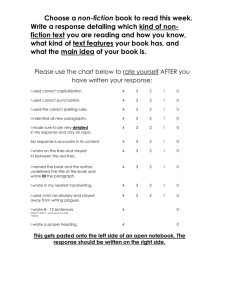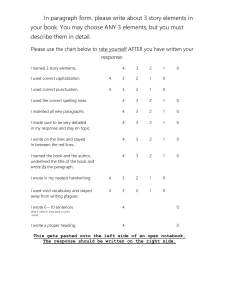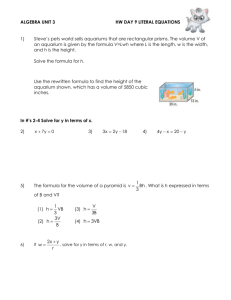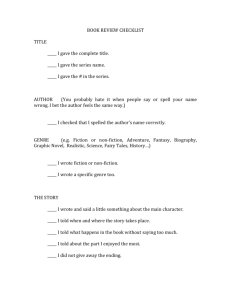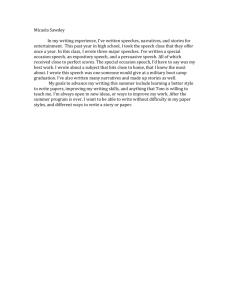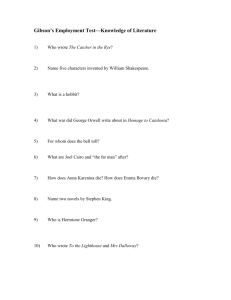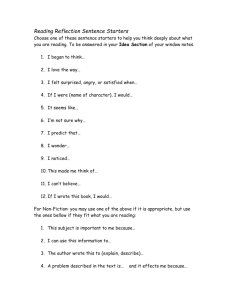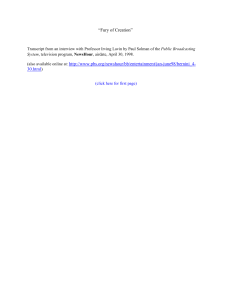Exam 2 Study Guide - Gordon State College
advertisement
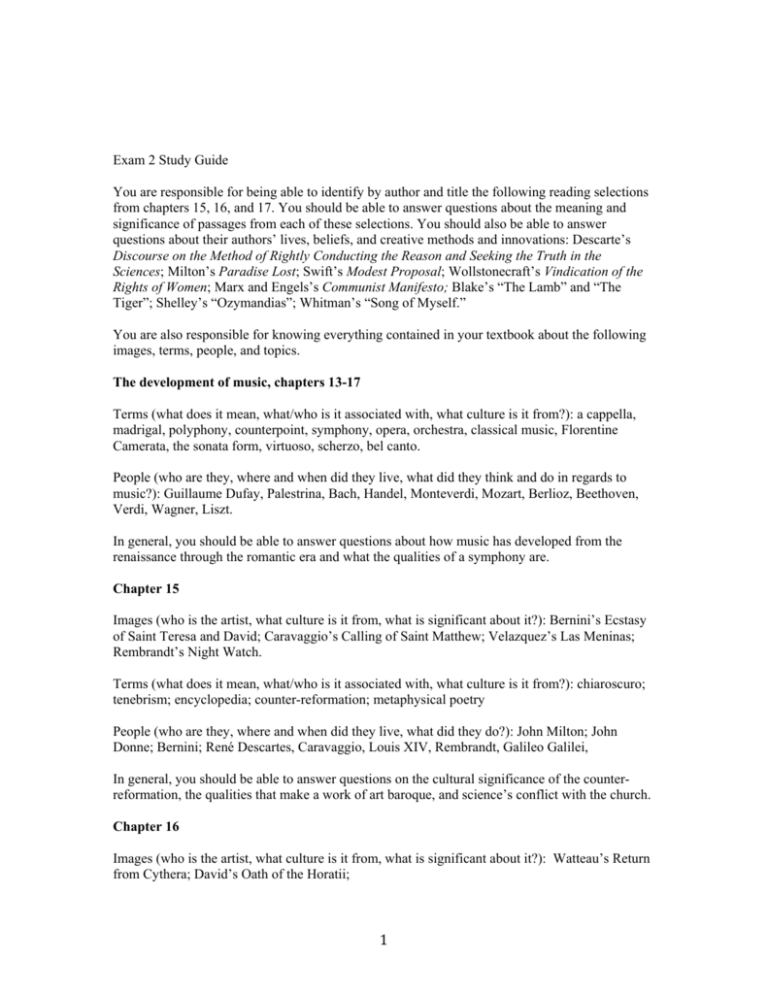
Exam 2 Study Guide You are responsible for being able to identify by author and title the following reading selections from chapters 15, 16, and 17. You should be able to answer questions about the meaning and significance of passages from each of these selections. You should also be able to answer questions about their authors’ lives, beliefs, and creative methods and innovations: Descarte’s Discourse on the Method of Rightly Conducting the Reason and Seeking the Truth in the Sciences; Milton’s Paradise Lost; Swift’s Modest Proposal; Wollstonecraft’s Vindication of the Rights of Women; Marx and Engels’s Communist Manifesto; Blake’s “The Lamb” and “The Tiger”; Shelley’s “Ozymandias”; Whitman’s “Song of Myself.” You are also responsible for knowing everything contained in your textbook about the following images, terms, people, and topics. The development of music, chapters 13-17 Terms (what does it mean, what/who is it associated with, what culture is it from?): a cappella, madrigal, polyphony, counterpoint, symphony, opera, orchestra, classical music, Florentine Camerata, the sonata form, virtuoso, scherzo, bel canto. People (who are they, where and when did they live, what did they think and do in regards to music?): Guillaume Dufay, Palestrina, Bach, Handel, Monteverdi, Mozart, Berlioz, Beethoven, Verdi, Wagner, Liszt. In general, you should be able to answer questions about how music has developed from the renaissance through the romantic era and what the qualities of a symphony are. Chapter 15 Images (who is the artist, what culture is it from, what is significant about it?): Bernini’s Ecstasy of Saint Teresa and David; Caravaggio’s Calling of Saint Matthew; Velazquez’s Las Meninas; Rembrandt’s Night Watch. Terms (what does it mean, what/who is it associated with, what culture is it from?): chiaroscuro; tenebrism; encyclopedia; counter-reformation; metaphysical poetry People (who are they, where and when did they live, what did they do?): John Milton; John Donne; Bernini; René Descartes, Caravaggio, Louis XIV, Rembrandt, Galileo Galilei, In general, you should be able to answer questions on the cultural significance of the counterreformation, the qualities that make a work of art baroque, and science’s conflict with the church. Chapter 16 Images (who is the artist, what culture is it from, what is significant about it?): Watteau’s Return from Cythera; David’s Oath of the Horatii; 1 Terms (what does it mean, what/who is it associated with, what culture is it from?): rococo, neoclassical, the Augustans, rational humanism People (who are they, where and when did they live, what did they do?): Jean-Antoine Watteau, Jacques-Louis David, Jonathan Swift, Alexander Pope, Rousseau, Wollstonecraft, Voltaire, Diderot, Montesque, In general, you should be able to answer questions from this chapter on how artists and thinkers of the period were inspired by the classical cultures of Rome and Greece and how writers of this time used satire Chapter 17 Images (who is the artist, what culture is it from, what is significant about it?): Goya’s The Third of May; Turner’s Slave Ship; Daumier’s Legislative Belly. Terms (what does it mean, what/who is it associated with, what culture is it from?): natural selection, realism, photosensitive, sturm un drang, gothic novel, romanticism, transcendentalism, natural selection, Byronic. People (who are they, where and when did they live, what did they do?): Baudelaire, Karl Marx, Charles Darwin, Kant, Hegel, Francisco Goya, Goethe, Charles Dickens, Byron, Emerson, Whitman, Shelley. In general, you should be able to answer questions about the concerns of romanticism and the development of romantic themes in visual art and literature You should come to the exam especially prepared to answer the following questions: 1. Karl Marx co-wrote The Communist Manifesto with a. Jefferson Alberts b. Vladimir Lenin c. Friedrich Engels d. Nobody, as the Manifesto has no co-author 2. bel canto is a style of a. poetry b. singing c. dance d. philosophy 3. The Florentine Camerata held that a. The polyphonic style in vocal music lacked complexity; more notes should be sung in increasingly complex counterpoint b. The Vatican should return to the traditions of monophonic chanting; the polyphonic style has exhausted itself c. There was no more sublime experience than the polyphony heard in the Sistine Chapel d. The polyphonic style in vocal music made the text incomprehensible; text should be sung in a single vocal line with instrumental accompaniment 4. Bach is known as a. The Father of Opera 2 b. c. d. The Inventor of the Symphony Orchestra The chief composer of the Vatican The figure who raised the art of polyphony to its highest level 5. Mozart composed a. Baroque music b. Classical music c. Renaissance music d. All of the above 6. Charles-Louis Montesquieu proposed a. a form of governance based on “checks and balances” that eliminated the possibility of a central dictatorial government b. a form of poetry free from the constraints of rhyme and meter c. that the natural goodness of the human race had been corrupted by the growth of civilization d. that the rich should eat the children of the poor 7. a cappella means a. beautiful singing “in the manner of opera” b. emotional singing “in the manner of lyric poetry” c. unaccompanied singing “in the manner of the chapel” d. None of the above 8. The Counter-Reformation is a. The organized resistance of northern European churches to the authority of the Roman church b. A style of art that emphasizes reformed images of divinity c. Bernini’s style of emphasizing states of heightened religious emotion d. The Roman church’s reassertion of the universality of the church and its authority in response to the Protestant Reformation 9. John Milton a. wrote Paradise Lost b. is a metaphysical poet c. invented the Encyclopedia d. ran the inquisition against Galileo Galilei 10. Galileo Galilei a. was put on trial in Rome for publishing his Dialog Concerning the Two Chief World Systems b. used his own telescopes to see craters on the moon, sunspots, and other signs of heavenly imperfection c. claimed that his observations through the telescope proved Copernicus right d. all of the above 11. Gian Lorenzo Bernini is known as a. the chief architect of Counter-Reformation Rome b. the father of modern physics c. the inventor of chiaroscuro d. the grand inquisitor 12. The rococo style a. emphasizes lightness and gaiety, with strong emphasis on romantic dalliance and the pursuit of pleasure for an aristocratic audience b. evokes the models, aims, and ideals of the Roman Republic c. emphasizes personal feelings, emotion, the fantastic and the exotic, and a mystical attachment to nature 3 d. uses the everyday events of the world around them to express their views of life 13. Realists a. emphasize lightness and gaiety, with strong emphasis on romantic dalliance and the pursuit of pleasure for an aristocratic audience b. evoke the models, aims, and ideals of the Roman Republic c. emphasize personal feelings, emotion, the fantastic and the exotic, and a mystical attachment to nature d. use the everyday events of the world around them to express their views of life 14. Denis Diderot designed his Encyclopedia to a. justify the ways of God to man b. describe the state of contemporary science, technology, and thought and provide a system for the classification of knowledge c. give Jim Britannica a full time job, with benefits d. serve as the only source that students consult when writing college research papers 15. The baroque style a. emphasizes simplicity b. is characterized by sparseness and crude technique c. avoids emotion and psychological exploration d. none of the above 16. Charles Darwin a. wrote The Communist Manifesto b. wrote On the Origin of Species c. wrote Fields of Grass d. wrote Vindication of the Rights of Women 17. Walt Whitman a. wrote The Communist Manifesto b. wrote On the Origin of Species c. wrote Leaves of Grass d. wrote Oliver Twist 18. Who among the following is not associated with the culture of Romanticism? a. Lord Byron b. Walt Whitman c. G.F. Hegel d. Wolfgang Amadeus Mozart 19. The Augustans a. Glorified English achievement under the monarchy b. Imitated the style of the Roman Augustan poets c. Celebrated the restoration of King Charles II d. All of the above 20. A symphony a. has four movements b. is a form of chanting c. is a play in which the dialog is sung d. all of the above 4
